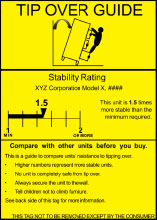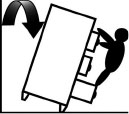CPSC Releases Artwork for Clothing Storage Unit Labels Required by New Safety Standard
Furniture World News Desk on
3/2/2023
The U.S. Consumer Product Safety Commission (CPSC) this week released the artwork necessary for product labeling required under the new Safety Standard for Clothing Storage Units, which goes into effect May 25, 2023.
All units meeting the functional definition of a clothing storage unit under the new rule and having a manufacture date of May 25, 2023, or later must carry a new tip-over warning label (see 16 CFR § 1261.5) as well as a hang tag (see 16 CFR § 1261.6) that displays the unit’s “stability rating” as calculated by the rule’s performance testing.
The warning label contains a three-panel pictogram and prescribed text. Content of the text varies, based on whether the unit is designed to hold a television and whether it has a drawer interlock system. The pictogram, shown below, contains three images, each of which must measure at least 1 inch by 1 inch. The "X" in the first panel must be red, and the checkmark in the third panel must be green. The third panel may be modified to show a specific anti-tip device included with the clothing storage unit.

A fourth image showing the word “TV” with a red line through it (as seen at the top of page 2) is required on units that are not designed to hold a television. This image, which also must be at least 1 inch by 1 inch, is the same as the one in the warning label required by the ASTM International F2057 voluntary standard since 2019.

The three-panel pictogram, as well as the “No TV” icon, are being made available to the industry by the American Home Furnishings Alliance. These can be downloaded from the Resource Links section of the Furniture Stability page on AHFA’s website. All documents in the Resource Links section, located in the lower half of the right-hand column, are available without a member log-in.
CPSC also has uploaded the three-panel pictogram (but not the “No TV” icon) to the Clothing Storage Unit Business Guidance page on www.cpsc.gov.
The warning label must be located on the interior side panel of a drawer “in the upper most drawer row,” according to the CPSC rule. For units with only doors, it must be on the interior side panel or back panel of the cabinet behind the door. Manufacturers should consult the rule for more detailed instructions on placement.
Units covered by the scope of the new rule and with a manufacture date of May 25 or later also must carry a hang tag that displays the unit’s “stability rating,” along with a technical explanation of that rating. This two-sided hang tag must be at least 5-by-7 inches, and the front side must have a process yellow background. A sample of the front of the hang tag is shown below, along with the graphic CPSC designed for the tag.


The icon of a child climbing a CSU that is needed for this hang tag also can be found under Resource Links on the Furniture Stability page of AHFA’s website, as well as on the CPSC CSU Business Guidance page.
“What you will not find on the CPSC website, or in the Federal Register, for that matter, is an accurate representation of the back of the hang tag,” notes AHFA Vice President of Communications Patricia Bowling. “AHFA has confirmed with the CPSC Small Business Ombudsman, Stephen Lee, that the image shown on the back of the hang tag in the Federal Register is incorrect.”
In Figure 2 within section 1261.6, the back of the hang tag shows a tipping CSU without a child climbing. Lee told AHFA: “The example is erroneously using the incorrect icon. The back of the hangtag should use the same icon as the front.”
Manufacturers should consult the rule for further hang tag instructions, including how to calculate the stability rating, the prescribed text for the front and the back of the tag, font sizes and placement on the unit.
“Again, one detail you will not find in the rule is how to adhere the tag. This seems obvious. Most hang tags ‘hang’ from a string of some sort, especially if they are two-sided and you expect consumers to be able to flip them from one side to the other,” Bowling observes. “But the layout prescribed by the CPSC rule does not include any space for a hole punch. Manufacturers will need to consider allowing additional space for a hole punch at the top of the 5x7 tag, clear of all front and back copy, or the tag will need to be larger than 5x7.”
The hang tag must be “clearly visible to a person standing in front of the unit” in a retail store. If it falls off or is damaged, it must be replaced. It must appear on the product and the “immediate container of the product.” Ready-to-assemble furniture must display the tag on the “main panel of consumer-level packaging.”
Manufacturers and importers that have a “sales interface” on their website must display the stability rating for each CSU that is offered for sale on the website. The rating must be in a font size “equivalent to that of the price, in proximity to the price.” In addition, the entire hang tag for each unit must be posted on the site and visible to the consumer through “one user action,” for example, one mouse click or mouse roll-over.
One final label is required on all CSUs covered by the scope of the CPSC rule. It is an identification label at least 2 inches wide by 1 inch tall. It must contain the following: Name and address (city, state and zip code) of the manufacturer, distributor or retailer; the model number; and the month and year of manufacture. It also must include the statement: “Complies with U.S. CPSC Safety Standard for Clothing Storage Units.” This label must be visible on the back of the unit when the unit is fully assembled. It does not contain any graphics.
About The American Home Furnishings Alliance
The American Home Furnishings Alliance, based in High Point, N.C., represents more than 200 leading furniture manufacturers and distributors, plus about 150 suppliers to the furniture industry worldwide.